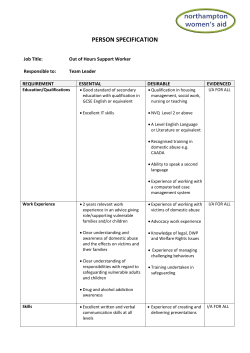
infographic as PDF - Australian Institute of Family Studies
Australian Government Australian Institute of Family Studies Child Family Community Australia Responding to children and young people’s disclosures of abuse Listen, reassure and respect Move to a suitable environment, free of distractions. Be calm and patient—allow for the child or young person to be heard. Listen Let the child or young person use their own words—avoid asking leading questions. Avoid “quizzing” the child or young person about details of the abuse. Don’t be afraid of saying the “wrong” thing. Listening supportively is more important than what you say. Reassure Reassure the child or young person that it is OK that they have told you what’s been happening. Address any concerns about the child or young person’s safety. Reassure the child or young person that he or she is not at fault, and not the cause of any distress you may feel. Respect that the child or young person may only reveal some details. Acknowledge the child or young person’s bravery and strength. Respect Avoid making promises you can’t keep—manage the child or young person’s expectations. Explain to the child or young person that in order for them to be safe you will need to report their experience to someone else. What happens next? If a child or young person discloses abuse, you should report it to the relevant authorities. Mandatory reporting requirements vary throughout Australian states and territories. For information about mandatory reporting requirements including who is mandated to report, see CFCA Resource Sheet Mandatory Reporting of Child Abuse and Neglect <www3.aifs.gov.au/cfca/publications/mandatory-reporting-child-abuse-and-neglect> State and territory contact details for reporting abuse and neglect are available on the CFCA Resource Sheet Reporting Abuse and Neglect: State and Territory Departments Responsible for Protecting Children <www3.aifs.gov.au/cfca/publications/reporting-abuse-and-neglect>
© Copyright 2025











